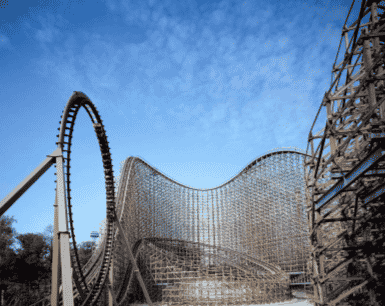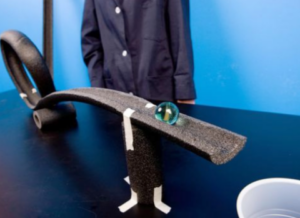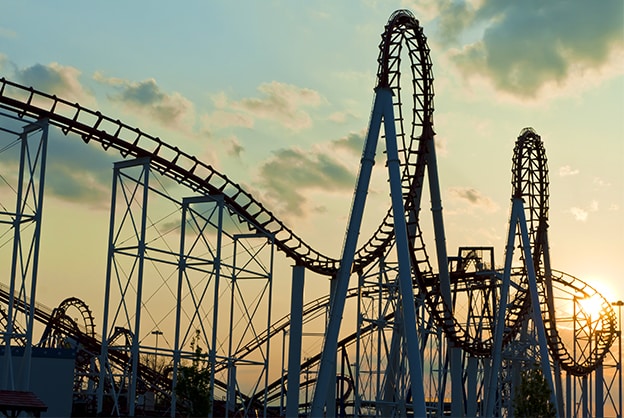Overview
STEM careers
Time
Materials
Per Team:
- 6-foot piece of flexible tubing, such as foam pipe insulation, sliced in half lengthwise
- 1 roll of masking tape
- 1 plastic cup
- 1 marble
- Supports (boxes, books, paper towel tubes, etc.)
- Scissors or utility knife
Relevant Terminology
Acceleration: The process of moving faster or happening more quickly. A roller coaster is designed to create lots of acceleration!
Centripetal force: The force that keeps an object on a curved path. When you are on a merry-go-round and you feel as if you’re going to fly off of it but instead you hold on and keep going around, you are experiencing centripetal force.
Friction: The force that slows objects down when they are rubbing against each other. Some things make lots of friction, like brakes on a tire, and some make very little friction, like skates on ice.

‘Son of Beast” roller coaster at King’s Island, Ohio. Roller coasters are engineered for thrills, but also structural support and safety. Credit: Carol M. Highsmith/Library of Congress.
Inertia: The tendency of an object in motion to stay in motion or an object at rest to stay at rest. If you’re zooming down the road on your bike, your bike doesn’t suddenly stop unless you put on the brakes. And if your bike is parked, it doesn’t suddenly start moving. Both of these are examples of inertia.
Kinetic energy: Energy of motion. The marble rolling along its course is using kinetic energy.
Momentum: The amount of mass in motion. An object’s momentum depends on how much matter (its mass) is moving and how fast it’s moving. A boulder speeding down a mountain has much more momentum than a marble rolling slowly across the floor, and would require much more energy to stop it. (For older participants: momentum is the product of an object’s mass and its velocity.)
Potential energy: Stored energy. Anything that can move but isn’t has potential energy. A marble before it starts rolling has potential energy. Once it starts rolling, it has kinetic energy.
Introduce
GETTING READY
Cut the tubing into 6-foot sections. Use scissors or a knife to cut the tubing in half lengthwise, creating two 6-foot troughs. If using foam pipe insulation, notice that there is already a slit along its length.
INTRODUCTION
Roller coasters work on 2 types of energy: potential and kinetic. The higher the hill on which a coaster starts its run, the more potential energy it has. As the coaster moves down the track, potential energy is converted into kinetic energy, or the energy of motion. Engineers use this knowledge to design coasters that thrill us with hills, dips, corkscrews, and loops. However, compared with the tops of those loops, corkscrews, and other features, the height of the first hill on a roller coaster is usually the highest so that the riders can use the potential energy gained at the beginning to carry them through the entire ride.
It is the job of engineers to design the supports that hold a coaster up, as well as the mechanisms that keep riders safe throughout the course. These safety features include the bars and belts that keep the riders from flying out of the car as it races around the tight corners and loops of the track. Engineers strive to build ever bigger and faster roller coasters in hopes that their coaster becomes the biggest, fastest, and most twisting ride in the world!
Instructions
Ask participants to describe how a roller coaster works. Have them think about coasters they have ridden.
- How did the ride start?
- What made the coaster move along the track?
- What made it exciting?
Introduce the design challenge. Participants should consider where they will place the elements of the roller coaster before building. Consider having them sketch their design on a sheet of paper before beginning construction. This is an important step in the engineering design process. It also allows you to ask questions about their design before they start to build.
Allow participants to build their designs. They should use the support items and tape to keep everything in place. Tape the starting point to a wall or fixed surface such as a table (participants can adjust the height later, if necessary). Place a plastic cup at the end to catch the marble.

Close-up of a marble on the roller coaster track. Credit: Museum of Science and Industry, Chicago.
Test the coasters and identify what worked and what didn’t work. Redesign and rebuild as necessary. Younger children may need help raising the start of their roller coaster high enough.
Evaluate the success of each design using the following criteria:
- Does the roller coaster have the required elements: 1 loop, 1 hill, 1 jump?
- Does the marble make it to the end without falling off the track?
- Does the marble land in the cup?
ACTIVITY VARIATIONS
Combine many sections of tubing to make a longer roller coaster.
Build supports out of K’NEX or rolled newspaper to make a freestanding roller coaster.
Design a contraption to lift the marble up to the start of the track, much like the chain that pulls a coaster to the top of a hill.
TROUBLESHOOTING
The marble may jump the track while banking. If the track cannot be twisted to correct this, encourage the builder to make a device with paper and tape to correct the problem.
Guiding questions
GUIDANCE FOR YOUNGER CHILDREN
QUESTIONS TO ASK AFTER THE ACTIVITY
- How was your final roller coaster similar to or different from the design you drew on paper?
- Should the loop go before the hill or after? Why?
- What made the marble roll?
- Where did your marble roll the fastest?
- Did your marble stay on the track through the loop-the-loop? What made this happen?
- How could you make your marble roll faster?
- Would you want to go on a roller coaster like the one you designed?
GUIDANCE FOR OLDER YOUTH AND ADULTS
QUESTIONS TO ASK AFTER THE ACTIVITY
- What could you change to make your coaster faster?
- What forces are acting on you while riding a roller coaster?
- How would you calculate the speed of your marble at the bottom of the hill?
Engineering & science connections
GUIDANCE FOR YOUNGER CHILDREN
Engineering Connections
Although roller coasters roll on tracks like a passenger train, they are not powered by an engine. Instead, roller coasters rely on gravity and momentum to pull the cars along the track. In order to gain enough energy to keep the roller coaster moving up hills, through loops, and over jumps, engineers design them so that the ride starts with a tall hill. The Cyclone, one of the most famous wooden roller coasters in the world, opened in 1927. The ride is over 2,600 feet long. The first drop on this ride is 85 feet high, which accelerates riders to 60 miles per hour. Accelerate means they go faster and faster until they are moving at 60 miles an hour, which is how fast cars go on a highway. Engineers are always trying to make newer coasters taller and faster. The Kingda Ka roller coaster at Six Flags Great Adventure in New Jersey is over 450 feet tall and accelerates riders to over 135 miles per hour!
Science Connections
Really big roller coasters usually begin with the cars climbing a massive hill that is designed to provide the roller coaster with enough starting energy to carry it through the entire ride. This energy is called potential energy. As the roller coaster gets higher in the air, this potential energy increases because the distance it can fall increases. Once a roller coaster begins rolling down the hill, the potential energy is then converted into another kind of energy called kinetic energy, which is the energy of motion.
To better understand this concept, imagine that a rock falls on your foot. If the rock fell from only a few inches above your foot, it would not hurt as much as if it had fallen from the top of a tall building. That is because when the rock falls from a higher point, it starts with more potential energy. As it falls, it goes faster and faster, meaning that its kinetic energy is growing. All of that kinetic energy is what you feel when the rock lands on and smashes your foot. Ouch!
GUIDANCE FOR OLDER YOUTH AND ADULTS
Engineering Connections
When designing a roller coaster, engineers add as many hills, loops, twists, and jumps as possible to make the thrill of the ride as great as possible. To accomplish this, engineers must look at the forces acting on people as they are being sent through these elaborate courses. Whenever there is a larger force in one direction or another, it results in acceleration. As the roller coaster slows down, speeds up, or changes direction, you feel this acceleration as you feel pressed against the seat, the restraining bar, or the side of the car.
Your body interprets acceleration in an interesting way, and engineers take advantage of this phenomenon to create rides that push these sensations to the limit. When the roller coaster is accelerating and pushing you forward, it actually feels to you like a force pushing you backward into your seat. When you and the car are plummeting down a long, steep hill, gravity is pulling down, but since the car is also accelerating downward, it is not pushing up against your body. For that reason, when you are in freefall like this, you feel weightless.
Science Connections
Have you ever noticed that as you go through a loop, your body feels as if it’s being pressed into the seat? The combination of your inertia and the curve of the loop makes a force that creates this feeling. As you approach the loop, your velocity is propelling you straight forward, but the tracks prevent you from following this path. As you enter the bottom of the loop, your body wants to keep moving in a straight line (a phenomenon called inertia), but the seat is forcing you to move along the curve of the tracks, making you feel especially heavy. As you travel around the loop, it feels as if you are being pushed toward the outside, which people often call “centrifugal force.” However, there is no such force. In fact, this “force” is really just your body wanting to keep moving in a straight line. The real force is acting inward toward the center of the circle and comes from the seat pushing against you. This force is known as centripetal force.
Activity created by the Museum of Science and Industry, Chicago. All rights reserved.
Supplemental content adapted for Dream Big Activities by the Carnegie Science Center.
Find more great activities at DiscoverE.org


0 Comments